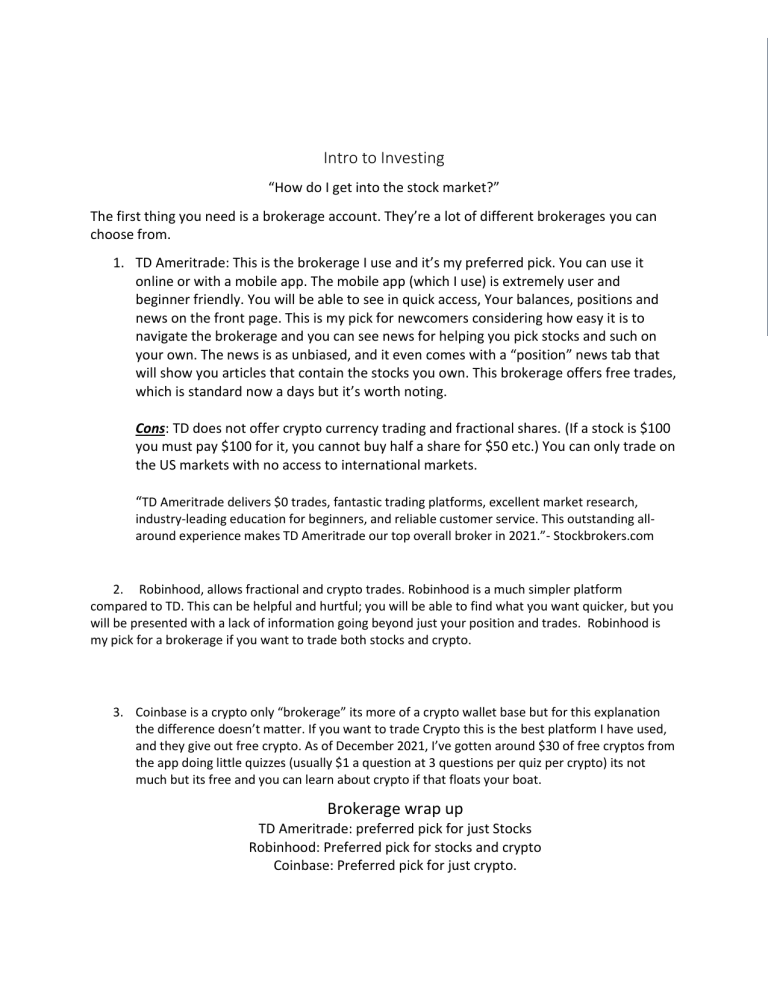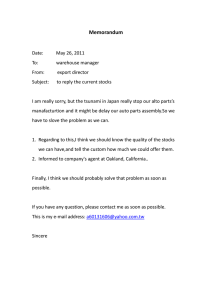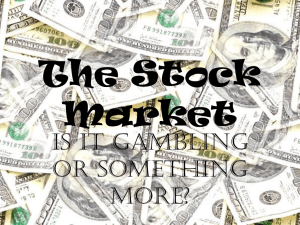
Intro to Investing “How do I get into the stock market?” The first thing you need is a brokerage account. They’re a lot of different brokerages you can choose from. 1. TD Ameritrade: This is the brokerage I use and it’s my preferred pick. You can use it online or with a mobile app. The mobile app (which I use) is extremely user and beginner friendly. You will be able to see in quick access, Your balances, positions and news on the front page. This is my pick for newcomers considering how easy it is to navigate the brokerage and you can see news for helping you pick stocks and such on your own. The news is as unbiased, and it even comes with a “position” news tab that will show you articles that contain the stocks you own. This brokerage offers free trades, which is standard now a days but it’s worth noting. Cons: TD does not offer crypto currency trading and fractional shares. (If a stock is $100 you must pay $100 for it, you cannot buy half a share for $50 etc.) You can only trade on the US markets with no access to international markets. “TD Ameritrade delivers $0 trades, fantastic trading platforms, excellent market research, industry-leading education for beginners, and reliable customer service. This outstanding allaround experience makes TD Ameritrade our top overall broker in 2021.”- Stockbrokers.com 2. Robinhood, allows fractional and crypto trades. Robinhood is a much simpler platform compared to TD. This can be helpful and hurtful; you will be able to find what you want quicker, but you will be presented with a lack of information going beyond just your position and trades. Robinhood is my pick for a brokerage if you want to trade both stocks and crypto. 3. Coinbase is a crypto only “brokerage” its more of a crypto wallet base but for this explanation the difference doesn’t matter. If you want to trade Crypto this is the best platform I have used, and they give out free crypto. As of December 2021, I’ve gotten around $30 of free cryptos from the app doing little quizzes (usually $1 a question at 3 questions per quiz per crypto) its not much but its free and you can learn about crypto if that floats your boat. Brokerage wrap up TD Ameritrade: preferred pick for just Stocks Robinhood: Preferred pick for stocks and crypto Coinbase: Preferred pick for just crypto. 1 Important terms to understand before the next segment A BULL market is when stocks are up 20% over a period. A BEAR market is when stocks are down 20% over a period. These are usually reserved for sustained periods of time not just a few days or a week. Examples of bear markets are 1. The great depression and the market crash in 2008. Bulls happen basically every other time. Since the market is always rising you can think of a Bull market as the regular flow of increases until the next “depression” that will drop the market by at least 20%. Bears constitute a sellers’ market and bulls a buyers’ market. Yahoo Finance You can see from 2007 until 2010 it was a bear market, from mid-2010 to the end of the chart (2017) is the Bull market as a default. 2 “What do I do once I make my brokerage account?” Before adding money and trading its important to know what you’re buying. The three important types of stocks for beginners to understand is Growth, dividend, and Defensive stocks. Growth stocks: The main reason people buy Growth stocks is because they grow, hence the name. On average these stocks do Good in bull markets and bad in bear markets. Growth stocks can supply dividends but its usually not enough to make much a difference in the short term. Examples of these stocks are Apple (APPL), Netflix (NFLX), and Amazon (AMZN) The letters in the parenthesis are the ticker symbols which is what you type in to search up said stock in the brokerages. Dividend stocks: These stocks on average do not gain or lose much value over the course of a period. What they are useful for is the Dividend they give usually on a quarter of a year basis. This means that every 3 months they will pay you back money. Example: A $100 stock that has a 2.5% Dividend Yield will give you back $2.5 PER SHARE during the year, 62.5 cents per 3 months per share. At first this seems amazing, but you need a sizeable amount of money to make these work for you. Dividend stocks are sometimes labeled as “Passive income” by people on social media and such. Dividends are a great tool to use in retirement as on average every $1,000,000 you have invested into dividend stocks you will earn around $100,000 a year. They are not some magic tools of free money some people make them out to be, but they are a useful tool in investing if used correctly in the right circumstances. The price of a dividend stock is not affected as much by Bull/ Bear markets compared to the growth stocks; they will almost never grow at the same rate as growth stocks. Examples of dividend stocks: PNW Pinnacle West Capital Corp. 5.23% LYB LyondellBasell Industries NV 5.19% CVX Chevron Corp. 4.75% SAFT Safety Insurance Group Inc. 4.66% Personally, I do not suggest investing in dividend stocks that has a Yield of over 6%, the higher the rate the more money they are giving to the public and the less money they are using to invest in themselves, so it becomes a slippery slope. You can view dividend payout dates through your brokerage or online, one such website is: https://www.nasdaq.com/market-activity/quotes/dividend-history 3 The third type of stock all beginners should know is the Defensive stock, these are sometimes referred to as “safe stock” or even “retirement stocks” Defensive stocks are known for their ability to stay tight to the change of the market. The stock market itself during a Bull phase might climb by 10% a year, in this scenario a growth stock might increase by 15% for example while a defensive stock will stick close to that 10% of the market itself. While this seems to be counteractive to your yearly gains, they are stable during the bad times as well. Most defensive stocks are consumer staples of the country. Defensive stocks are amazing to have in your retirement accounts as you know over the course of multiple decades, they will be able to make steady growth. Examples of Defensive stocks: Procter & Gamble (PG) Johnson & Johnson (JNJ) Coca-Cola (KO) Defensive stocks to keep in mind are utility companies. Water, energy and gas stocks are nice due to their stability, and they usually give dividends because they do not keep profits on average (research individual utility stocks to make sure of dividend rates before you buy) Precious metals such as gold and silver are good are another example of defensive measures to have protection against bear markets. ETF & INDEX Funds These are not stocks themselves but are traded on the stock market and is one of the best tools for new investors. ETFs are a pool of stocks combined into one fund to help limit risk. Most ETFs have a collection of at least 10 different stocks, when those stocks do well the ETF overall does well. These types of funds embody the phrase” don’t put all of your eggs in one basket” instead of owning individual stocks you can own ETFs that have the stocks you want so that you don’t lose as much money when the individual stocks lose money. ETFs can be traded the same way all other stocks can eb traded, any time during trading hours. Index funds are like ETFs but can only be bought and sold at the end of the trading day for a price set by the head of the index fund. Popular examples of these ETFs and Index funds are as follows Fidelity ZERO Large Cap Index (FNILX) 0% management fee Vanguard S&P 500 ETF (VOO) SPDR S&P 500 ETF Trust (SPY) .03% management fee .09% management fee Management fees are low, so they do not matter much but its something to take account of, you are paying them a small fee to be able to own these stocks. A Company manages these funds to make sure you have a collection of what they think is the best possible. You can find ETFs for many sectors including, Financial (FNCL), Health (RYH), Real estate (NURE), and Technology (RYT) ETC. Different ETFs per sector are easy to find on google. 4 Investing Strategy for newcomers with time to spare I would like to start this section off with a disclaimer that I will not be covering day trading. Day trading without enough practice and knowledge is basically gambling. I would not suggest Day Trading without a couple months of your own independent research into different strategies and understanding patterns unless you want to lose your money quickly. If you wish to practice on a simulation, I recommend Thinkorswim, A Free real time market simulation of the stock market that you can trade and invest on with Simulated money. https://www.tdameritrade.com/tools-and-platforms/thinkorswim.html The first strategy for investing is going to be for people who want to long term invest. In this terminology long term investing will be keeping your stocks for at least one year to capitalize on long term gains tax. While it is for one year, I recommend applying this mentality basically for anybody who is not in need of retirement soon. The longer you can invest the longer you will be able to capitalize on compound interest and such. To start off, you will want to use mostly growth stocks, you can put in a bit of dividend stocks if you feel you want some small extra income, but it won’t make much of a difference until you have a sizeable chunk of cash flows into your dividend portfolio. I would want to make sure your portfolio is at least 90% growth stocks considering we don’t have to play incredibly safe at the age you are investing in. Below is an Example of what you can do with a $10,000 starting investment, this method can scale but its just nice to have some room to play with in the simulations for you to learn from. So, what we have here for our portfolio is as follows 40 shares of Apple (AAPL) at $179.20 per share for a total of $7,168 35 shares of S&P 500 ETF (SPLG) at 56.24 per share for a total of $1,968.4 15 shares of a finance ETF (FNCL) for 56.27 per share for a total of $844.05. In this example we bought apple because they are up 38% from January 2021 to December 2021. Apple is a fantastic growth stock because they have proved over the years, they will be able to surpass the market. Apple is also a good pick because while they are not a dividend stock, they give dividends so the longer you hold you can earn free shares over the long run. Apple has a Dividend yield of .49% which is low but it’s more of an extra bonus then a downside. You simply will not find a perfect growth stock with a high yield to be a sustainable investment. 5 SPLG was purchased as a replacement for SPY. These stocks track the Standards and poor 500, to put it simply you can view them as a representation of the entire market. I would suggest buying SPY if you have the money, but since it trades closer to $500 as of the time writing this, its not a sustainable investment for long term growth compared to other stocks. SPLG and SPY are defensive stocks, but its nice to have in your pocket with a little bit of extra cash you have. Be wary of cheaper versions of SPY though because they do not have as much liquidity, this basically means its harder to buy and sell them frequency because not a lot of people will be buying them when you sell and vice versa. This is not an issue for us because we will be keeping these stocks for a while so you can afford to have the order take a tad bit longer. An order of SPY might be completed in a few seconds as SPLG might take a few minutes or even an hour, when you factor that into you holding onto it for a year or multiple years compared today trading it for profit then it really doesn’t matter much. Since its about nine times cheaper its worth the bit of liquidity issues with new traders as you can gain more profit per share. SPLG has a 1.24% dividend yield as a small bonus as well. FNCL is currently the prized gem of financial sector ETFs. A 40% increase from the beginner of the year (do not expect these gains forever as we are coming off the beginning of the pandemic stock scare) while that is the case, they have grown 60% from the start of 2017 for a 10% yearly increase averaged over the 6 years. They have a Dividend yield of 1.74% 6 Fidelity.com If you remember from before FNCL is an ETF, this means they are compilations of companies put into one stock holding. On the TD Ameri trade app, it is under the “portfolio” section when you are viewing a stock. You can see from the screenshot above that FNCL is 99.57% financial companies. This means the stock will do well in markets that benefit the finance sector which I will discuss later. From the picture we can also gather that 385 different companies are in this ETF which makes it incredibly stable compared to just one company. If you only own Bank of America and their value goes down then your entire portfolio drops, with this ETF they only contribute to 6.58% of the ETF so you can still benefit from the gain of value of other companies in while BAC (bank of America) goes down. If you have $1000 or less, I suggest finding an ETF in a growing sector that is around $50$80 so that you can make some gains without falling into the pitfalls of only owning 1-2 shares of an expensive stock. If this situation apple is also a good option if you choose to only buy a small number of different stocks and grow the volume of shares over time. Investing for people later in life Its never too late to invest, but the later in life you are the less you will be able to benefit from compounding interest. To begin, think of long-term investing as a sliding scale, the closer you are to your end goal the more conservative you want to be with your money, assuming your goal is realistic. For example, if you have $60,000 saved up and you want to hit $70,000 in 2 years its much more realistic to play it safe then to just risk it all and maybe hitting your goal or maybe going broke. So, for sake of discussion our end goal here will be retirement, and I would say the average American making the average amount of money for their age you should start playing it safe if you start investing within 10 years of retirement. In this case you want to focus on defensive stocks so that you can safely grow your money, but you don’t have to worry much if you will be in a bear or bull market. Most people will want to have around $1,000,000 saved up for retirement. If you start your investments at age 55 (about 10 years pre-retirement) that gives you about 10 years to save up $100,000 per year which just is not realistic for the average salary of a 55-year-old which is $77,308.78 per year, given to us by DQYDJ.com which is a respected economical and finance website. So now that we know we can’t hit the desired goal at this age without saving any money up before we can go into caution mode and try to damage control the situation. Ideally you will be investing up to 10% of your income per month into your account. In this situation you I would still suggest a 401k account since you will be able to contribute up to $26,000 a year past age 50 compared to the $7,000 you can put into a Roth IRA per year. Now that we know where we want to put the money, we need to find out what we are going to invest in. your portfolio should be a combination of mostly defensive stocks with a bit of room for growth stocks that pay dividends. Since we are playing it safe, I suggest sticking to a small number of stocks that will grow with the market such as SPY. At 10 years out I would suggest have around 80% of your portfolio with 7 an ETF that follows the S&P 500 such as SPY or VOO. The other 20% I would keep it simple with a stock like Apple. Its important not to make this process too complicated as you want to just grow these and you don’t want to make a lot of changes to your retirement account. As always do your own research which stocks fit into these situations so that you can feel confident in your decisions. Options and Futures If you trade options and futures without 100% understanding what you are doing you can quite literally lose your entire account balance in 5 seconds… gone…. Forever, you will never get it back. Basically, what options are, is that you buy a packet of 100 shares of a stock for cheaper and you predict what the price of the stock will be in the future, the closer you get the more money you make and the further the more you lose. Its not meant for an intro to investing course, im just telling you not to do it so you don’t lose everything on accident. Margin Margin is borrowed money in your account that you obtain once you reach a certain threshold of cash in your brokerage account. Each brokerage has different limits of value. For TD Ameritrade you must have at least $2,000 in your account and then you must keep 30% of your total value worth as equity. In the example above, TD will show you 4 values that will show your overall account value. Account Value: The total amount of money you have available to you deposited on the account. Total Cash: The amount of cash on your account that is not invested and available to be withdrawn Positions: The total amount of value of stocks owned on this account. Margin balance: The amount of Margin borrowed on this account to purchase stocks. 8 The example above shows us that the owner of this account has $26k ≃ with $16k ≃ to form a total of $42k ≃ stock bought on the account. The advantages this gives is that you can make gains on 42k worth of money while only having to actually put in 26k. the downsides of this is that if you fall under the margin balance, they will issue what is called a “margin call” A margin call is when you fall under the margin requirement and the brokerage wants their money back. Looking above we can see the same account from the previous example. Looking at Margin Equity we can find that this account has a total of around $26k of value. Our margin requirement is only $19,716.49 so if this account has its value above that $19k then no margin call will be issued. We can only see some useful information in the middle in which this account has a margin excess of $6,350.48, this just helps so we don’t need to do the math and we know how much margin we are borrowing over the requirement. I keep mentioning a margin call but what exactly is a margin call? A margin call is when you fall under the requirement and the brokerage you are borrowing money from loses faith in your account. This means they will give you a couple of options. You can either add funds to your account to get back to the margin requirement or you can sell off stock to lower the requirement and meet them in the middle. Its important to not trade under margin unless you are extremely confident because if you get caught with a margin call you are losing your actual money for being greedy with your account value. Now that we know not to trade with margin, I think its appropriate to give a few tips to people who disregard the previous section and trade with margin anyways. Check daily your account status and value and make sure that you have enough over the requirement you can act quick enough to sell off the margin. Looking at the example above we know this person is 9 $6,000 over the margin limit, since they would have to lose over $6,000 to even be temped with a margin call, they have enough time to react to the losses and sell off some margin to help mitigate the damage. Quick wrap up 1. Open a Brokerage account, in settings do not select options or margin allowed. 2. Fund your account. 3. Research which stocks you want to purchase; buy stuff you’re interested in but what also fits to your strategy. 4. Don’t get emotional and sell off when you lose a little bit of money.




